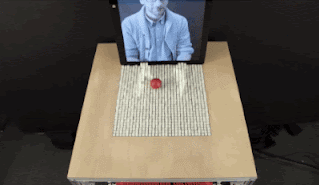Nothing is impossible under--er, around--the sun.
Each pin can be moved up and down individually by actuators to create a topographical rendering of an object -- it might be a city plan, a data visualization or simply the outline of someone's hands. The physical form of the surface can be augmented with mapped projections, thanks to an overhead Kinect and projector.
The team at MIT that is behind inFORM explain it as a "Dynamic Shape Display that can render 3D content physically, so users can interact with digital information in a tangible way. inFORM can also interact with the physical world around it, for example moving objects on the table's surface. Remote participants in a video conference can be displayed physically, allowing for a strong sense of presence and the ability to interact physically at a distance." Read more at: http://phys.org/news/2013-11-mit-group-realm-interaction-future.html#jCp
The team at MIT that is behind inFORM explain it as a "Dynamic Shape Display that can render 3D content physically, so users can interact with digital information in a tangible way. inFORM can also interact with the physical world around it, for example moving objects on the table's surface. Remote participants in a video conference can be displayed physically, allowing for a strong sense of presence and the ability to interact physically at a distance." Read more at: http://phys.org/news/2013-11-mit-group-realm-interaction-future.html#jCp
Bringing a new meaning to video calls
Applications of MIT's InForm
With this, urban planners and architects can view 3D designs physically and, thus, can easily show their ideas. The Marble Answering Machine, designed by Durrell Bishop, is another useful application of InForm where it somehow redefines the usual appearance and mechanism of a typical answering machine. Voice messages which are represented as physical marbles. Marbles are stored at the top of a little "hill" created by the interface. When the person receives a message, a marble is manipulated by the pins and moved into a small "well" at the bottom of the slope. To listen to the message, users pick up the marble from the new message well and place it inside a separate "play" well. Once played, the machine moves into the "old message" well. It can be deleted by being deposited back at the top of the hill.
According to MIT TMG's website, InForm is a step toward their vision of Radical Atoms:
For the mean time, InForm is built on a small scale. But just think of all the possibilities and changes in can make! We're living in a 3D world anyway.
Sources:
Owano, Nancy. MIT group's shape display steps to new realm in interaction future. Web. phys.org. Retrieved 17 December
Solon, Olivia. MIT researchers develop InForm, a shape-shifting display surface. Web. wired.co.uk.
Retrieved 17 December
Souppouris, Aaron. MIT's shapeshifting display lets you reach out and touch someone. Web. theverge.com. Retrieved 17 December 2013
tangible.media.mit.edu
youtube.com
According to MIT TMG's website, InForm is a step toward their vision of Radical Atoms:
To address this challenge, we presented our new vision, “Radical Atoms”, in 2012. Radical Atoms takes a leap beyond Tangible Bits by assuming a hypothetical generation of materials that can change form and appearance dynamically, becoming as reconfigurable as pixels on a screen.
Radical Atoms is a computationally transformable and reconfigurable material that is bidirectionally coupled with an underlying digital model (bits) so that dynamic changes of physical form can be reflected in digital states in real time, and vice versa.
Radical Atoms is the future material that can transform their shape, conform to constraints, and inform the users of their affordances. Radical Atoms is a vision for the future of human-material interaction, in which all digital information has a physical manifestation so that we can interact directly with it. We no longer think of designing the interface, but rather of the interface itself as material. We may call it “Material User Interface (MUI).”
For the mean time, InForm is built on a small scale. But just think of all the possibilities and changes in can make! We're living in a 3D world anyway.
Sources:
Owano, Nancy. MIT group's shape display steps to new realm in interaction future. Web. phys.org. Retrieved 17 December
Solon, Olivia. MIT researchers develop InForm, a shape-shifting display surface. Web. wired.co.uk.
Retrieved 17 December
Souppouris, Aaron. MIT's shapeshifting display lets you reach out and touch someone. Web. theverge.com. Retrieved 17 December 2013
tangible.media.mit.edu
youtube.com


0 comments